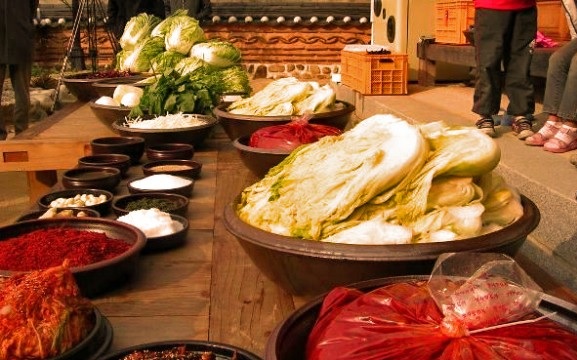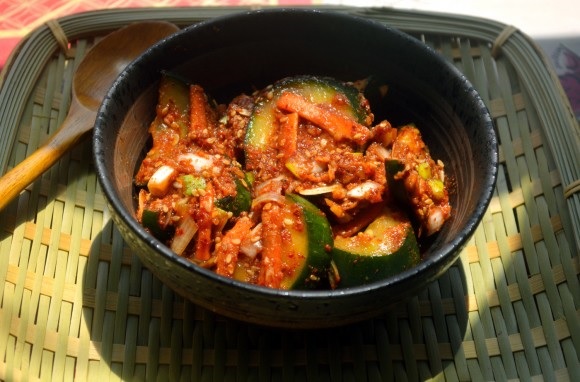Kimchi in the West is usually spicy and hot and made from Napa cabbage. That version is delicious, but it means many of us don’t know what we’re missing. Although the Napa cabbage version is delicious, this fascinating fermented Korean dish can be made from any vegetable, and its flavors can be savory, mild and slightly sweet. There are more than 100 kimchi varieties, another 80 rarely used ancient versions and countless derivative dishes, including pancakes, omelets, soups and stews, salads, stir-fries and noodles. One standout in the spring and summer is cucumber kimchi, which is delicious and easy to prepare. It can be ready to serve relatively rapidly, or eaten after a short fermentation, but before choosing one type of kimchi, it’s best to have a sense of what might suit your palate.
Kimchi’s regional and seasonal variations
Kimchi varies widely by where and how it is produced, the season it is made and how it is enjoyed once created. In the northern part of the Korean peninsula, kimchi is usually less salty and spicy than that produced in the south. Often, kimchi produced in northern coastal areas is flavored with fresh fish or shellfish, and kimchi from southern coastal areas uses salted fish or shellfish to flavor savory varieties. In the middle parts of the peninsula there is a wide variation in the types of kimchi produced, and it is characteristic of production in the middle and eastern part of the country to bury or ferment the kimchi for longer periods — lending a stronger flavor to the final product.
Although most people in the West think all kimchi is buried for a long time and is powerfully flavored, modern kimchi tends to be made pretty quickly. It takes about a week from mixing to ready to serve, and most Koreans tend to enjoy their kimchi a bit on the sweet and spicy side. Modern technology, such as the invention of a refrigerator made specifically for kimchi, has obviated the need for kimchi production in strict accordance to the availability of seasonal vegetables. Still, Koreans tend to produce and eat kimchi according to seasonal tradition.
The biggest kimchi-producing season is late autumn or early winter after the harvest. Women will often come together to make huge amounts of kimchi at this time. Salted Napa cabbage is a popular center for the kimchi made in autumn, and this is often supplemented by Korean radish greens, parsley or occasionally cilantro, and ground red chili peppers. In the autumn, saltier, more savory or fishy varieties are commonly produced and enjoyed. There are also some varieties eaten in the late autumn and winter that use little or no chili peppers. These varieties are known as white kimchi or water kimchi. In the middle part of the peninsula, it is also common to use pumpkin, squash or carrots as the kimchi center, although leeks and turnips are used, too.
In the spring and summer, vegetables are fermented as they are harvested from the garden, often with lots of potherbs such as spinach, chard and fiddlehead ferns as well as other leafy greens used to flavor the kimchi of young radishes, cucumbers and early carrots. Kimchi made at this time is usually consumed quickly and not left to ferment for long periods, so usually it has a milder flavor.
Making kimchi
Despite its reputation, making kimchi is rather simple and well worth the effort. One of the things I like best about homemade kimchi is that it has much less salt than the typical commercial product and no citric acid or other preservative, which burns my mouth. I also like to serve different types of kimchi so people can enjoy those varieties, such as sweet or savory, that are often unavailable to consumers in the West. No matter what type, kimchi is good for you. It is packed with probiotic organisms to get the gut going and keep it going. Kimchi can also be loaded with nutrients. Napa cabbage kimchi is particularly high in vitamin A and calcium.
And it’s endlessly fascinating. If you travel to Seoul, go to the second lower-level of the Coex building and check out the Kimchi Museum. The museum includes information about kimchi history, kimchi-making processes, and a data room with books and papers about kimchi and other Korean traditional foods. There are also regular demonstrations of kimchi making and, of course tastings.
Cucumber kimchi can be served as part of a multicourse banchan presentation in a Korean meal, and they make great summer party and picnic dishes, too. I like a slight fermented bite to the kimchi, and make it at least one day in advance of serving.

Cucumber Kimchi
Ingredients
1-pound pickling cucumbers
1 to 2 tablespoons coarse Korean sea salt
1 small bunch spring onions (6 to 8 stalks) sliced
1 tablespoon minced garlic
2 to 3 teaspoons grated ginger
1 cup soybean sprouts or thinly sliced carrot
⅓ to ½ cup Korean hot pepper flakes
1 tablespoon salted shrimp
2 tablespoons cane sugar (I use a natural sugar such as jaggery or demerara)
¼ cup water
1 to 2 tablespoons lightly roasted sesame seeds
¼ to ½ cup Asian chives (optional)
Directions
1. Wash the cucumbers well. For a quick, easy-to-eat presentation, simply slice the cucumbers diagonally down the length of the vegetable. Alternatively, one can quarter the cucumber lengthwise across about three-quarters of its length, leaving an uncut area at the bottom.
2. Place cucumbers in a bowl and salt well, making sure salt is well distributed. Transfer to a colander and let sit. After about 15 minutes, rinse the cucumbers well and shake to drain. Set aside.
3. Mix other ingredients together and let sit for 10 minutes or so to mix the flavors and allow the chili pepper flakes to hydrate. If you like Asian chives, use them. I find their strong flavor easily overwhelms the rest of the ingredients for this kimchi, and generally omit them.
4. Mix the ingredients from Direction No. 3 with the fully sliced cucumbers, or stuff the partially cut cucumbers. At this point, one can eat immediately, chill and then eat, or place into a sterilized canning jar, cap tightly and leave out overnight to start the fermentation before refrigerating. It depends on whether you want the kimchi super fresh, or whether you want it a little bit tangy and fermented.
(Words and recipe by Laura Kelley. Photo of Cucumber Kimchi by Laura Kelley. Photo of Kimchi Preparations by Caroline Knox / Wikimedia.)
(Originally published in Zester Daily)

